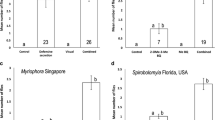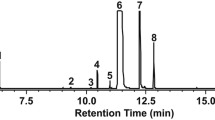Summary
The primary components of the defensive secretions ofBlaps mucronata (Tenebrionidae) are two quinones (methyl-p-benzoquinone and ethyl-p-benzoquinone) and the hydrocarbon 1p-n-tridecene. The hydrocarbon is shown, by comparison with longer- and shorter-chainn-alkanes and 1-n-alkenes, to be optimally suited as carrier of the quinones, and as a surfactant that promotes spread of secretion over the beetle's body following discharge from the gland openings at the abdominal tip. As shown from repellency tests with ants (Monomorium pharaonis) and topical irritancy tests with cockroaches (Periplaneta americana), the antiinsectan potency of the secretion derives as much from the hydrocarbon as from the quinones.
Similar content being viewed by others
References
Alexander P, Barton DHR (1943) The excretion of ethylquin-one by the flour beetle. Biochem J 37:463–465
Bettini S (1978) Arthropod venoms. (Handbook of experimental pharmacology, vol 48) Springer, Berlin Heidelberg New York, pp 1–977
Blum M (1981) Chemical defenses of arthropods. Academic Press, New York
Conner J, Camazine S, Aneshansley D, Eisner T (1985) Mammalian breath: Trigger of defensive chemical response in a tenebrionid beetle (Bolitotherus cornutus). Behav Ecol Sociobiol 16:115–118
Dean J (1980) Effect of thermal and chemical components of bombardier beetle chemical defense: glossopharyngeal response in two species of toads (Bufo americanus, B. marin us). J Comp Physiol 135:51–59
Dettner K (1984) Isopropylesters as wetting agents from the defensive secretion of the rove beetleCoprophilus striatulus F. (Coleoptera, Staphylinidae). Insect Biochem 14:383–390
Dettner K, Schwinger G, Wunderle P (1985) Sticky secretion from two pairs of defensive glands of rove beetleDeleaster dichrous (Grav.) (Coleoptera: Staphylinidae): Gland morphology, chemical constituents, defensive functions, and chemotaxonomy. J Chem Ecol 11:859–883
Duffey SS (1976) Arthropod allomones: Chemical effronteries and antagonists. Proc XV Int Congr Entomol, Washington, pp 323–394
Eisner T (1958) Spray mechanism of the cockroachDiploptera punctata. Science 128:148–149
Eisner T (1961) Demonstration of simple reflex behavior in decapitated cockroaches. Turtox News 39:196–197
Eisner T (1966) Beetle's spray discourages predators. Nat History 75:42–47
Eisner T, Meinwald J, Monro A, Ghent R (1961) Defense mechanisms of arthropods. I. The composition and function of the spray of the whipscorpion,Mastigoproctus giganteus (Arachnida, Pedipalpia). J Insect Physiol 6:272–298
Eisner T, Aneshansley D, Eisner M, Rutowski R, Chong B, Meinwald J (1974) Chemical defense and sound production in Australian tenebrionid beetles (Adelium spp.). Psyche 81:189–208
Eisner T, Kriston I, Aneshansley D (1976) Defensive behaviour of a termite (Nasutitermes exitiosus). Behav Ecol Sociobiol 1:83–125
Eisner T, Alsop D, Hicks K, Meinwald J (1978) Defensive secretions of millipeds. In: Bettini S (ed) Arthropod venoms. (Handbook of Experimental Pharmacology, vol 48) Springer, Berlin Heidelberg New York, pp 41–72
Happ GM (1968) Quinone and hydrocarbon production in the defensive glands ofEleodes longicollis andTribolium castaneum (Col., Tenebrionidae). J Insect Physiol 14:1821–1837
Heikertinger F (1944) Natur-Urkunden aus der Käferwelt. III. Die Starrstellung derBlaps. Koleopt Rundsch 30:159–162
Ikan R, Cohen E, Shulov A (1970) Benzo- and hydroquinones in the defense secretions ofBlaps sulcata andBlaps wiedemanni. J Insect Physiol 16:2201–2206
Jefson M, Meinwald J, Nowicki S, Hicks K, Eisner T (1983) Chemical defense of a rove beetle (Creophilus maxillosus). J Chem Ecol 9:159–180
Peschke K, Metzler M (1982) Defensive and pheromonal secretion of the tergal gland ofAleochara curtula. I. The chemical composition. J Chem Ecol 8:773–783
Razakov RR, Kasimov AK, Aslanov KH, Sadykov AS (1980) A study of complex mixtures of natural compounds by defocusing and DADI methods I. Repellents of darkling beetleBlaps m. Biorg Khim 6:944–950
Roelofs WL, Brown RL (1982) Pheromones and evolutionary relationships of Tortricidae. Annu Rev Ecol Syst 13:395–422
Rossini FD (1947) Selected values of properties of hydrocarbons. Dept of Commerce, National Bureau of Standards
Schildknecht H, Weiss KH (1960) Über die Tenebrioniden Chinone bei lebendem und totem Untersuchungsmaterial. Z Naturforsch 15 b: 757–758
Tschinkel WR (1975a) A comparative study of the chemical defensive system of tenebrionid beetles. Defensive behavior and ancillary features. Ann Entomol Soc Am 68:439–445
Tschinkel WR (1975b) A comparative study of the chemical defensive system of tenebrionid beetles: Chemistry of the secretions. J Insect Physiol 21:753–783
Tschinkel WR (1975c) A comparative study of the chemical defensive system of tenebrionid beetles. III. Morphology of the glands. J Morphol 145:355–370
Weatherston J (1973) Chemicals produced by arthropods. In: Altman PL, Dittmer DS (eds) Biology data book, vol 2. Fed Am Soc Exp Biol, Bethesda, Md, pp 680–693
Author information
Authors and Affiliations
Additional information
Paper no. 82 of the seriesDefensive Mechanisms of Arthropods
Rights and permissions
About this article
Cite this article
Peschke, K., Eisner, T. Defensive secretion of the tenebrionid beetle,Blaps mucronata: Physical and chemical determinants of effectiveness. J. Comp. Physiol. 161, 377–388 (1987). https://doi.org/10.1007/BF00603963
Accepted:
Issue Date:
DOI: https://doi.org/10.1007/BF00603963




